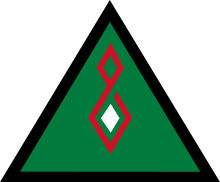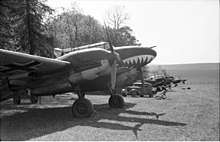Fliegerführer Irak
Flyer Command Iraq (German: Fliegerführer Irak)[nb 1] was a unit of the German Air Force (Luftwaffe) sent to Iraq in May 1941 as part of a German mission to support the regime of Rashid Ali during the Anglo-Iraqi War. The mission was part of a larger effort to gain support in the Middle East for the Axis Powers against the United Kingdom and its allies during World War II.
| Fliegerführer Irak | |
|---|---|
 Iraqi aircraft marking, 1941 | |
| Active | 2–31 May 1941 |
| Country | Kingdom of Iraq |
| Type | Air Wing |
| Size | 2 Squadrons |
| Part of | Luftwaffe |
| Garrison/HQ | Berlin |
| Engagements | Anglo-Iraqi War |
| Commanders | |
| Notable commanders | Generalleutnant Hans Jeschonnek and Oberst Werner Junck |
Background
On 1 April 1941, Rashid Ali and members of the "Golden Square" led a coup d'état in Iraq. During the time leading up to the coup, Rashid Ali's supporters had been informed that Germany was willing to recognize the independence of Iraq from the British Empire, there had also been discussions on matériel being sent to support the Iraqis and other Arab factions in fighting the British.
German Foreign Minister Joachim von Ribbentrop persuaded Nazi dictator Adolf Hitler on 3 May that Dr. Fritz Grobba be secretly returned to Iraq to head up a diplomatic mission to channel support to the Rashid Ali regime.[1] Grobba's mission was accompanied by a military force commanded by the Oberkommando der Wehrmacht, or OKW (the High Command of the Armed Forces). The military mission had the cover name Sonderstab F (Special Staff F); it included components from the Abwehr-based Brandenburgers and from the Luftwaffe. Sonderstab F was commanded by General der Flieger Hellmuth Felmy.[2] Fliegerführer Irak (Flyer Command Iraq) was the Luftwaffe component of Sonderstab F. While Fliegerführer Irak was part of the Sonderstab F military mission, it was also somewhat separate from it. Its personnel reported to the Luftwaffe High Command and not to the Chief of the OKW.[3]
On 6 May, in accordance with the "Paris Protocols", Germany concluded a deal with the Vichy French government to release war matériel, including aircraft, from sealed stockpiles in Syria and transport them to the Iraqis. The French also agreed to allow the passage of other weapons and stores as well as loaning several airbases in northern Syria, to Germany, for the transport of their aircraft to Iraq.[4]
Also on 6 May, Luftwaffe Oberst Werner Junck received instructions in Berlin that he was to take a small force of aircraft to Iraq. The force was named Special Force Junck (Sonderkommando Junck)[1] Junck met Reichsmarschall Hermann Göring and was named Commander of Aviation Iraq. (Fliegerführer Irak)[2] Junck was then briefed by Generalleutnant Hans Jeschonnek, Göring's Chief of Staff. While under Junck's tactical direction, Sonderkommando Junck was to be under the overall direction of Jeschonnek. The aircraft of Sonderkommando Junck had Iraqi markings and operated from an air base in Mosul, some 240 miles north of Baghdad.[1]
Initial composition
Fliegerführer Irak was to consist of a squadron of Messerschmitt Bf 110 zerstörer heavy fighters (12 aircraft) from the 4. Staffel/ZG 76, and a squadron of Heinkel He 111 bombers (12 aircraft). In addition, to assist in transporting the force to Iraq, Junck was lent 13 Junkers Ju 52/3m trimotor transports and Junkers Ju 90 four-engined transport aircraft. All but three of these transports had to be returned to Greece immediately to prepare for the invasion of Crete.[1][nb 2].
Junck was accompanied to Iraq by Major Axel von Blomberg. It was von Blomberg's task to head a reconnaissance group that was to precede the unit[2] and to integrate Fliegerführer Irak with Iraqi forces in operations against the British.[1]
Arrival

Dr. Grobba and his mission reached Aleppo in Syria on 9 May. They were accompanied by two Messerschmitt Bf 110s. On 11 May, they reached Baghdad.
On 13 May, the bulk of Junck's force arrived in Mosul. The flight had taken the aircraft some 36 hours and covered 1200 miles. Over the following days, Junck's aircraft became increasingly frequent visitors to Baghdad.
Junck's transport aircraft began to stage through Aleppo to Mosul on 14 May. On this date, a further three Messerschmitt Bf 110s and three Heinkel He 111s arrived in Mosul. Due to damaged rear wheels, two over-loaded Heinkel He 111s were left in Palmyra in central Syria. British fighters illegally entered Vichy French air-space and strafed the disabled Heinkels.
On 15 May, Junck arrived in Mosul with a further nine aircraft. By the end of the day, he had assembled a force comprising 12 Messerschmitt Bf 110s, 5 Heinkel He 111s, a communications flight with light aircraft, a section of anti-aircraft guns, and 3 Junkers Ju 52s.[7]
Activities
British forces had already begun to counterattack in Iraq. By 15 May, Junck knew that "Habforce" was on its way to RAF Habbaniya and "Kingcol" had taken Rutba Fort. Junck sent a lone Heinkel bomber to find "Kingcol" at Rutba. The bomber found and attacked "Kingcol", which alerted the British to the German military assistance to the Iraqi regime.
On the same day, von Blomberg was sent by Junck to Baghdad to make arrangements for a council of war with the Iraqi government. The council was planned for 17 May. However, von Blomberg was killed by friendly fire from Iraqi positions. His Heinkel He 111 was shot at from the ground as it flew low on approach and von Blomberg was found to be dead upon landing.[nb 3].
Junck visited Baghdad in place of von Blomberg on 16 May. He met Dr. Grobba, Rashid Ali, General Amin Zaki, Colonel Nur ed-Din Mahmud, and Mahmud Salman. The group agreed on a number of priorities for Fliegerführer Irak. The first was to prevent Kingcol from reaching RAF Habbaniya. The second was for Iraqi ground forces to take Habbaniya with air support provided by Fliegerführer Irak. It was also very important to the Germans to provide the Royal Iraqi Army with a "spine straightening." Much of the RIrA was known to be terrified of bombing by British aircraft.
On the same day, Junck arranged for a raid by Fliegerführer Irak on Habbaniya. Six Messerschmitt Bf 110s and 3 Heinkel He 111s attacked the base, which took the RAF personnel there by surprise. However, while a number of defenders were killed on the ground, the Germans lost a Heinkel in exchange for an Audax and a Gladiator.
On 17 May, three Messerschmitt Bf 110s attacked an extended column of Kingcol in the open desert. Luckily for the British, the fighters had not attacked the previous day when many vehicles were caught up to the axles in soft sand.[8]
On the same day, the British Royal Air Force (RAF) paid Junck back with his own coin. Two cannon-firing, long-range Hawker Hurricanes which had arrived unannounced from Egypt, and six Bristol Blenheim bombers from 84 Squadron, struck the Germans at Mosul. For the loss of one Hurricane, two German aircraft were destroyed and four damaged. In addition, two Gladiator biplane fighters from Habbaniya encountered two Messerschmitt 110s attempting to take off from Rashid Airfield in Baghdad. Both Messerschmitts were destroyed.
By 18 May, Junck's force had been whittled down to 8 Messerschmitt Bf 110s, 4 Heinkel He 111s, and 2 Junkers Ju 52s. This represented a roughly 30 percent loss of his original force. With few replacements available, no spares, poor fuel and aggressive attacks by the British, this rate of attrition did not bode well for Fliegerführer Irak. By the end of May, Junck had lost 14 Messerschmitts and 5 Heinkels.[9]
Hitler issued "Führer Directive No. 30 on 23 May."[10] Among other things, it said
"The Arab Freedom Movement in the Middle East is our natural ally against England. In this connection special importance is attached to the liberation of Iraq ... I have therefore decided to move forward in the Middle East by supporting Iraq."
On 27 May, twelve Italian Fiat CR.42 biplane fighters of the Regia Aeronautica (Royal Italian Air Force) arrived in Mosul to operate under German command.[11] By 29 May, Italian aircraft were reported over Baghdad.[12] According to Winston Churchill, the Italian aircraft accomplished nothing.[13] Other reports state that they actually arrived in time to take part in the final air battle of the Iraq campaign on 29 May, scoring victories against No. 94 Squadron RAF.[14]
Grobba sent a panicked message from Baghdad to Berlin on 28 May reporting that the British were close to the city with more than "one hundred tanks." By then, Junck had no serviceable Messerschmitt Bf 110s and only two Heinkel He 111s with just four bombs between them.[15]
The German military mission to Iraq left under cover of darkness on 29 May. Dr. Grobba himself fled Iraq the next day.[15]
Commanders
- Lieutenant General Hans Jeschonnek – 6 May 1941 to 29 May 1941 (in Europe)
- Colonel Werner Junck – 6 May 1941 to 29 May 1941 (in Iraq)
See also
- Bombing of Palestine in World War II
- Syria-Lebanon Campaign
- Martin Drewes
- Paul Zorner
- Wilhelm Herget
- Foreign Affairs/Defence Office of the Armed Forces High Command (Abwehr)
- Kampfgeschwader 4
- Zerstörergeschwader 76
Footnotes
- Some sources indicate that this unit was named "Special Force Junck" (Sonderkommando Junck)
- Playfair states this force was made up initially of 14 Messerschmitt 110s and 7 Heinkel 111s.[5] Lyman states it was 12 Heinkel 111s and 12 Messerschmitt 110s.[1] Mackenzie states the force consisted of 15 Heinkel 111s and 14 Messerschmitt 110s.[6] Kurowski states the force consisted of 9 Heinkel 111s and 12 Messerschmitt 110s.[2]
- Lyman indicates von Blomberg was shot down by Iraqi troops while Kurowski indicates that he was shot when Arab tribesmen fired into the air and was found to be dead upon landing
References
- Citations
- Lyman, p. 63
- Kurowski, p. 131
- Kurowski, p. 141
- Playfair (1956), pp. 194–195
- Playfair (1956), p. 195
- Mackenzie, p. 100
- Lyman, pp. 64–65
- Lyman, p. 60
- Lyman, pp. 66–68
- Kurowski, p. 140
- Playfair (1956), pp. 196
- Wavell, p. 4095
- Churchill, Chapter 14, The Revolt in Iraq, p. 234
- Thomas 2002, p. 81
- Lyman, p. 84
- Bibliography
- Churchill, Winston (1985) [1950]. "Chapter 14: The Revolt in Iraq". The Second World War, Volume III, The Grand Alliance. Boston: Houghton Mifflin Company. ISBN 0-395-41057-6.
- Lyman, Robert (2006). Iraq 1941: The Battles for Basra, Habbaniya, Fallujah and Baghdad. Campaign. Oxford, New York: Osprey Publishing. p. 96. ISBN 1-84176-991-6.
- Kurowski, Franz (2005). The Brandenburger Commandos: Germany's Elite Warrior Spies in World War II. Mechanicsburg, Pennsylvania: Stackpole Book. ISBN 978-0-8117-3250-5.
- Mackenzie, Compton. Eastern Epic: Volume 1 September 1939 – March 1943 Defence. London: Chatto & Windus. OCLC 59637091.
- Playfair, Major-General I.S.O.; with Flynn R.N., Captain F.C.; Molony, Brigadier C.J.C. & Toomer, Air Vice-Marshal S.E. (2004) [1st. pub. HMSO 1956]. Butler, J.R.M (ed.). The Mediterranean and Middle East, Volume II The Germans come to the help of their Ally (1941). History of the Second World War, United Kingdom Military Series. Naval & Military Press. ISBN 1-84574-066-1.
- Thomas, Andrew (2002). Gloster Gladiator Aces. Botley, UK: Osprey Publishing. ISBN 1-84176-289-X.
- Wavell, Archibald (1946). Despatch on Operations in Iraq, East Syria and Iran from 10th April, 1941 to 12th January, 1942. London: War Office. in "No. 37685". The London Gazette (Supplement). 13 August 1946. pp. 4093–4102.
External links
- "Archibald Wavell's Despatch on Operations in Iraq, East Syria, and Iran From 10th April, 1941 to 12th January 1942" (PDF). Supplement to the London Gazette, Number 37685. 13 August 1946. Retrieved 26 September 2009.
- "With Roosevelt in Iraq". Time Magazine. 2 June 1941. Retrieved 17 July 2009.